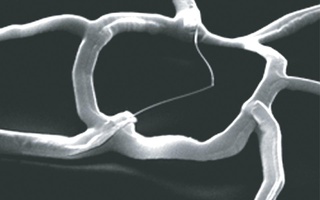Park has done work defining the electrical properties of nanotubes. His recent research has focused on how the interactions of electrons moving through nanotubes can be predicted and explained with quantum mechanics.
These tubes could potentially be used as the primary conductive element in computers or other electronic devices.
But there are problems.
Although there are various ways to make them, nanotubes can be randomly generated in carbon soot. But no one has yet announced a way to make nanotubes to pre-set specifications.
"The problem with nanotubes is you can't control chirality", explain Yi Cui, graduate student researcher in the Lieber group.
Chirality, or the exact geometric arrangement of the atoms in the nanotube, effects how electrons move through the tube. Electrons moving along the tubes are sensitive to the chirality. Since chirality cannot be controlled, the electrons act in unpredictable ways, for example bouncing back the way they came.
Nanowires do not have such limitations. Approximately three nanometers across, nanowires can be synthesized by a technique called laser assisted catalytic growth.
Read more in News
Council Supports Online Concentration GuideRecommended Articles
-
Women's Lacrosse Drops to TerriersThe end of Spring Break hits all Harvard students hard. Yesterday, the women's lacrosse team had its rude awakening. After
-
Chemistry Professor Garners Prize for Nanotech InnovationHyman Professor of Chemistry Charles M. Lieber recently received this year’s World Technology Award for Materials for his work in
-
Team Develops Nanowire RingsHarvard researchers have developed a breakthrough nanowire technology integrated into high-tech electronic circuits—which, among other things, could help manufacturers significantly
-
Research Assists Cancer TestsHarvard researchers have found new ways of assembling nanowires—ultra-thin wires that have the potential to revolutionize electronics—and a new application
-
Chemistry Researchers Bend NanowiresA group of researchers in the lab of chemistry professor Charles M. Lieber have found a way to synthesize two- and three-dimensional versions of the microscopic strands known as nanowires—a breakthrough that researchers say may greatly increase the reach and applicability of the field by allowing scientists to design vastly more complex structures.
-
 ‘Cyborg Tissue’ Created
‘Cyborg Tissue’ Created













